Mastering smoked ribs—whether they are St. Louis style ribs, spare ribs, or baby back ribs—with our comprehensive tutorial and recipe will make you a backyard all star.
You can make it happen. Love Kansas City-style saucy ribs? We got you. Prefer Memphis-style dry rubbed ribs? No problem. Here’s the real smoked ribs recipe for both styles, good enough to bring home a trophy in a cook-off. In fact, many readers have done exactly that with this “Last Meal Ribs” recipe.
Now it’s time to master the basic concepts, after which you’ll be cooking killer authentic smoked BBQ ribs on almost any charcoal and gas grill, whether dry rubbed or sauced, spare ribs or baby backs, or St. Louis style spare ribs!
How this smoked BBQ ribs recipe got its name
This easy low-and-slow barbecue ribs recipe needed a name when I first published it, and Doug and Trudy Calvin of Palm Springs, CA provided it. He wrote “I fixed ribs yesterday by following your recipe. My girlfriend made me promise that for her last meal on this planet I would fix the same ribs.” I have to agree I’d make these for my last meal too. Ever since then, I’ve called them Meathead’s Last Meal Ribs.
Forget the 3-2-1 method for ribs
Many websites tout the “3-2-1 method.” It says you should smoke a slab of ribs for 3 hours, then wrap it in foil for 2 hours, then take it out of the foil for 1 hour. Don’t do it.
Sterling Ball of BigPoppaSmokers.com and winner of the prestigious American Royal in Kansas City says “I’d like to kill the man who came up with the 3-2-1 concept. He’s ruined more meat…”
I and every champion competitor I know agree. Two hours in foil is waaaay too long for pork ribs, especially if there is liquid in the foil. Beef brisket needs two hours or more in foil, but not ribs. I think anything more than 1 hour softens the meat too much and makes it mushy.
Experiment until you and your cooker get it the way you like it best. Your mileage might vary. This recipe is a set of guidelines not hard-and-fast rules.
If you boil ribs the terrorists win
A lot of folks boil their ribs before grilling them and slathering on the sauce. The concept comes from Eastern Europe where Poles and Czechs prepare ribs by simmering them in water with cabbage, potatoes, carrots, and caraway seed, making a very nice pork stew.
But water is a solvent. It pulls much of the flavor out of the meat, and it can make the meat mushy. When you boil meat and bones, you make a rich flavorful soup. All that color in the pot is flavor that you can never get back into the meat. Boil meat too much and water can even dry it out by causing the proteins to contract and squeeze the moisture out of the muscle fibers.
People talk wistfully about meat that falls off the bone, but if it does, it has probably been boiled and denuded of its best flavors. What they’re really loving is the unctuous barbecue sauce. That’s why McDonald’s McRibs are so popular. They’re just ground pork swimming in sweetened ketchup mixed with liquid smoke and some other flavors. Classic Southern ribs have the same mouthfeel and bite as a tender juicy steak and most important, they taste like pork, not just sauce. An authentic smoked BBQ ribs recipe results in meat that tugs off the bone rather than fall off the bone.
If you are really really in a hurry, you are better off steaming or microwaving them and then finishing them on the grill or under the broiler.
Just don’t boil ’em!
Click here for my complete definition of Amazing BBQ Ribs, what I look for when I judge barbecue ribs in competitions.
How to get meatier baby back ribs
The best advice I will ever give you: Develop a relationship with your butcher.
Baby back ribs are cut from the loin so the amount of meat on the baby backs is determined by your butcher.
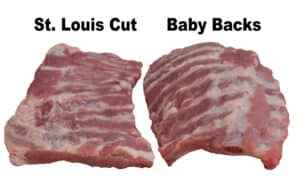
Most grocers and butcher shops get their baby backs pre-cut in boxes, and the amount of meat on the ribs is determined by the price the store feels it can charge, and what the competition forces them to charge.
Even if they get their baby backs pre-cut, many butchers also get whole bone-in rib roasts.
If you ask nicely, your butcher may be willing to custom cut the baby back ribs off the rib roast leaving extra meat on them. Want baby backs with 1/2″ of meat on top? No problem? Want a whole inch? No problem. Expect to pay more for these extra meaty ribs, but the result is worth it.
A better option: Just buy the whole bone-in rib roast and then ask the butcher to remove the baby backs leaving about 1/2″ of meat on them. Then keep the de-boned loin meat for roasting separately. Yummmmmm!
Not sure about which type of ribs to buy? Our friend Heath Riles has a good video on the topic.
Hardware needed for this smoked BBQ ribs recipe
1 smoker or grill with a lid. You can use a dedicated smoker or any charcoal grill or gas grill as long as it has a lid. A tight fitting lid with adjustable vents like those on the Weber Kettle is best.
1 (18 pound) bag of charcoal for charcoal grills or smokers. You won’t use all that charcoal, but because you will need more on cold, windy, or wet days than on sunny and warm days, have a full bag on hand. I prefer briquets (read my article on charcoal to see why). Absolutely do not use the instant igniting stuff that has solvent in it. Chimney starters are by far the best way to start charcoal, especially for long slow cooking where the smell of the solvent in charcoal starter fluid can ruin the taste of the meat. Read my article on how to start a charcoal fire.
- A tank of propane for gas cookers. You won’t need it all, but, until you get the hang of this technique, don’t risk running out by starting with a partial tank.
- Long handled tongs
- One sauce brush, preferably one of those newfangled silicone brushes
- A good digital oven thermometer
- A six pack of beer (for the cook, not the meat)
- One lawn chair
- Good books and plenty of tunes
Can’t make it outside? Here’s how to make BBQ ribs in the oven or how to make BBQ ribs in a slow cooker.
There are several very good recipes for dorm dwellers, folks with no grills, and for blizzard days.
Best Stovetop Ribs: Mexican Ribs with Rice. Arroz con Costillas de Cerdo is a great stove-top recipe with ribs swimming in a lush, juicy sauce on a bed of rice.
Smoky Sauna Indoor Ribs. This recipe takes the concepts of this recipe and adapts them for your indoor oven.
Cabin Fever Slow Cooker Ribs. Toss these in your slowcooker and let them braise all day. Their fragrance will knock you over when you come home.
Chinatown Char Siu Ribs. Everybody loves those Chinese restaurant ribs. How do they do it? The secret is not the sauce, it’s the marinade. You can do them at home on the grill or in the oven.
Hoisinful Nine Dragon Ribs. These may be the best Chinese ribs you ever tasted. And you can cook them indoors.
Chinese Five Spice Riblets. Fried and crispy, flavored with five spice powder, these ribs are the perfect finger food for parties.
If you like this recipe, you’ll love…
Rendezvous Ribs. How they make ribs fast at the famous Rendezvous restaurant in Memphis.
Vermont Pig Candy. The secret is mmmmmmaple syrup.
Tuscan Marinated Ribs. This recipe calls for marinating the meat in an herbed oil and vinegar bath and roasting without smoke. The results are complex and exotic.
Competition ribs. Here are the tweaks the top competitors do to win big money.
Sous-Vide-Que Ribs. Amazingly tender and juicy.
Soy Ginger Glazed Ribs. Sweet, salty, tangy.
Rib Sandwich. Far better than McRib.
Hungry for more ribs recipes, tips, and techniques? Click here to download our ebook “Amazing Ribs Made Easy” $3.99 on Amazon (free Kindle app runs on all computers and devices). Or, get this book and others FREE as a member of the AmazingRibs.com Pitmaster Club. Click here to join.
Makes:
1 rack of ribsTakes:
Ingredients
- 1 slab ribs any cut (baby back, spare ribs, St. Louis cut)
- 4 tablespoons Meathead's Memphis Dust (see notes below if you would prefer to use our bottled pork rub)
- 1 teaspoon Morton Coarse Kosher Salt (¼ teaspoon per pound of meat)
- 6 tablespoons barbecue sauce (Sauce is optional. See notes below if you would prefer to use our bottled KC BBQ sauce)
These recipes were created in US Customary measurements and the conversion to metric is being done by calculations. They should be accurate, but it is possible there could be an error. If you find one, please let us know in the comments at the bottom of the page
Method
- Prep. Rinse the ribs in cool water to remove any bone bits from the butchering.

- If the butcher has not removed the membrane from the under side, do it yourself. It gets leathery and hard to chew, it keeps fat in, and it keeps sauce out. To remove it, insert a butter knife under the membrane, then your fingers, work a section loose, grip it with a paper towel, and peel it off. If you can't get the skin off, with a sharp knife, cut slashes through it every inch so some of the fat will render out during the cooking. To see more photos of how to skin 'n' trim ribs, click here. And here's a quickie 1 minute video of the technique.
- Trim the excess fat from both sides of the rack of ribs.
- Next it is time to add the salt. The rule of thumb is 1/2 teaspoon of kosher salt per pound of meat, but ribs are about 50% bone, so use about 1/4 teaspoon per pound. You can simply eyeball it by sprinkling on the same amount of salt you would sprinkle on the ribs if they were served to you unsalted. If you can, give the salt 1 to 2 hours to be absorbed. The process of salting in advance is called dry brining.
- Before adding a BBQ rub, be aware of double salt jeopardy! Rubs and spice blends are a great way to add flavor to meat, but almost all commercial rubs contain salt so be careful not to pre-salt the ribs if you plan on using one of these rubs otherwise they will be unbearably salty. Also note that some ribs sold in grocery stores are labeled as "enhanced" or "flavor enhanced" or "self-basting" or "basted," meaning that they have been injected with a brine at the packing plant so if you are using these you probably want to use a rub that doesn't include salt like our Meathead's Memphis Dust recipe.Some folks insist on putting the barbecue rub on the night before, but it isn't necessary. The molecules in spices are too large to penetrate more than a tiny fraction of an inch. For the science of marinating, read this article.
- Before applying the rub, just coat the meat with a thin layer of water. The water helps dissolve the spices. A lot of cooks like to use mustard under the rub as a form of glue. Mustard is water, vinegar, and maybe white wine (all mostly water) with mustard powder mixed in. The amount of mustard powder is so small that by the time the water steams off and drips away, the mustard powder remaining is miniscule. My experience is that using a mustard slather makes little or no difference in the final outcome. If you want a mustard flavor, you will do much better by simply sprinkling it on the meat. Once wet, sprinkle enough Meathead's Memphis Dust to coat all surfaces but not so much that the meat doesn't show through. That is about 2 tablespoons per side depending on the size of the slab. Spread the Memphis Dust on the meat and rub it in.
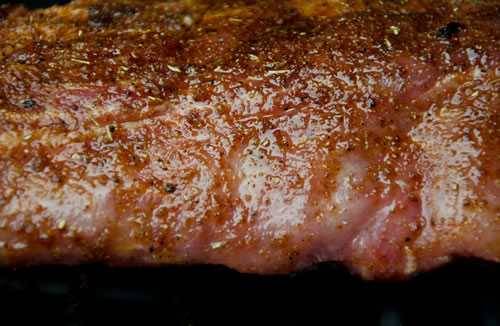
- Fire up. Pre-heat your barbecue smoker or set up your grill for 2-zone (indirect) cooking. Adjust the dampers on your cooker to bring the temperature to about 225°F (107°C) and try to keep it there throughout the cook. Cooking at 225°F (107°C) will allow the meat to roast low and slow, liquefying the collagen in connective tissues and melting fats without getting the proteins knotted in a bunch. It's a magic temp that creates silky texture, adds moisture, and keeps the meat tender. If you can't hit 225°F (107°C), get as close as you can. Don't go under 200°F (93°C) and try not to go over 250°F (121°C).When monitoring the cooker temperature you can absolutely positively noway nohow rely on bi-metal dial thermometers. If you are not monitoring your cooker with a good digital oven thermometer, you are setting yourself up for disappointment. Using a dial thermometer is like trying to send email with a typewriter. Click here to read my buyer's guide to thermometers.Once you have reached the desired temperature, add about 4 ounces (113 g) of dry wood, placing it as close to the flame as possible.
- Cook. Put the slabs in the cooker in indirect heat, meaty side up, close the lid, go drink a beer, read a book, or make love.
- When the smoke dwindles after 20 to 30 minutes, add another 4 ounces (113 g) of wood. After that, DO NOT add any more wood. On your first attempt, resist the temptation. Nothing will ruin a meal faster and waste money better than over-smoked meat. You can always add more the next time you cook, but you cannot take it away if you over-smoke.
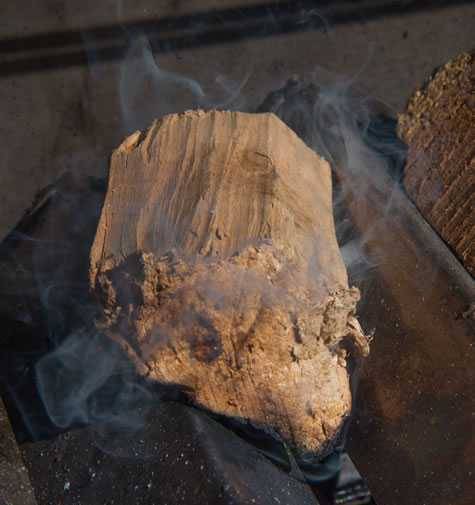
- If you have more than one slab on, halfway through the cook you will need to move the ribs closest to the fire away from the heat, and the slabs farthest from the flame in closer. Leave the meat side up. There is no need to flip the slabs. You can peek if you must, but don't leave the lid open for long.
- This next step is known as the Texas Crutch. This optional trick involves wrapping the slab in foil with about an ounce of water for up to an hour to speed cooking and tenderize a bit. Almost all barbecue ribs competition cooks use the Texas Crutch to get an edge. But the improvement is really slight and I never bother for backyard cooking. If you crutch too long you can turn the meat to mush and time in foil can soften the bark and remove a lot of rub. I recommend it only for barbecue competitions when the tiniest improvement can mean thousands of dollars. Skip it and you'll still have killer ribs. But if you've seen it on TV and must try it, click here to learn more about The Texas Crutch. The Texas Crutch is it is baked into a popular technique called the 3-2-1 method which I do not recommend. Two hours in foil or butcher paper is far too long and can make the meat mushy. Try the Texas Crutch after you master the basics.
- For cooking time, allow 5 to 7 hours for St. Louis Cut (SLC) Ribs or Spare Ribs, and 3 to 5 hours for Baby Back Ribs. Thicker, meatier slabs take longer. If you use rib holders so they are crammed close to each other, add another hour.
- When it is time to find out whether or not the ribs are ready, we us the bend test (a.k.a. the bounce test). Although we insist that you buy a good digital meat thermometer for most smoking and grilling, this is one of the few meats on which you cannot use a meat thermometer because the bones have an impact on the meat temp and because the meat is so thin. If you have a really thin probe and can keep it away from bone, shoot for about 200°F. Yes, that's right. Wayyyyy past well done, but that's needed to break down the tough connective tissues.To conduct the bend test, pick up the slab with tongs and bounce it gently. If the surface cracks as in the picture above, it is ready. Here are some other tricks for how to tell when ribs are ready.
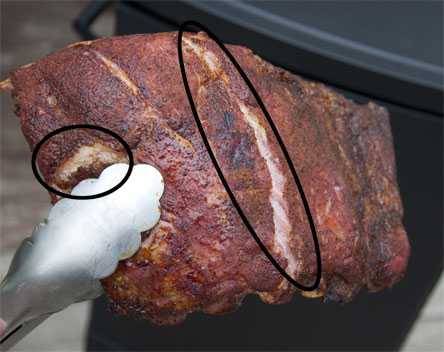
- Once the ribs are done cooking it is time to add the sauce unless you intend to serve them "dry" like they do in Memphis. The key to saucing ribs is to go easy on it so that the meat can shine through. Simply paint both sides of the rack with your favorite home made barbecue sauce or store-bought barbecue sauce and cook for another 15 minutes or so. Don't put the sauce on earlier than that. It has sugar and there is a risk it can burn. Now here's a trick I like: Sizzle on the sauce. Put the ribs with sauce directly over the hottest part of a grill in order to caramelize and crisp the sauce. On a charcoal grill, just move the slab over the coals. On a gas grill, crank up all the burners. On a water smoker, remove the water pan and move the meat close to the coals. On an offset smoker, put a grate over the coals in the firebox and put the meat there. With the lid open so you don't roast the meat from above, sizzle the sauce on one side and then the other. The sauce will actually sizzle and bubble. Stand by your grill and watch because sweet sauce can go from caramelized to carbonized in less than a minute! One coat of a thick sauce should be enough, but if you need two, go ahead, but don't hide all the fabulous flavors under too much sauce. If you think you'll want more sauce, put some in a bowl on the table.
- Serve. Once sauced, slice the rack between the bones. If you've done all this right, you will notice that there is a thin pink layer beneath the surface of the meat. This does not mean it is undercooked! It is the highly prized smoke ring caused by the combustion gases and the smoke. It is a sign of Amazing Ribs. Now plate, serve to your guests, and take a bow when the applause swells from the audience.

- Finally, here's a video from our fan Jason King that shows the whole process.

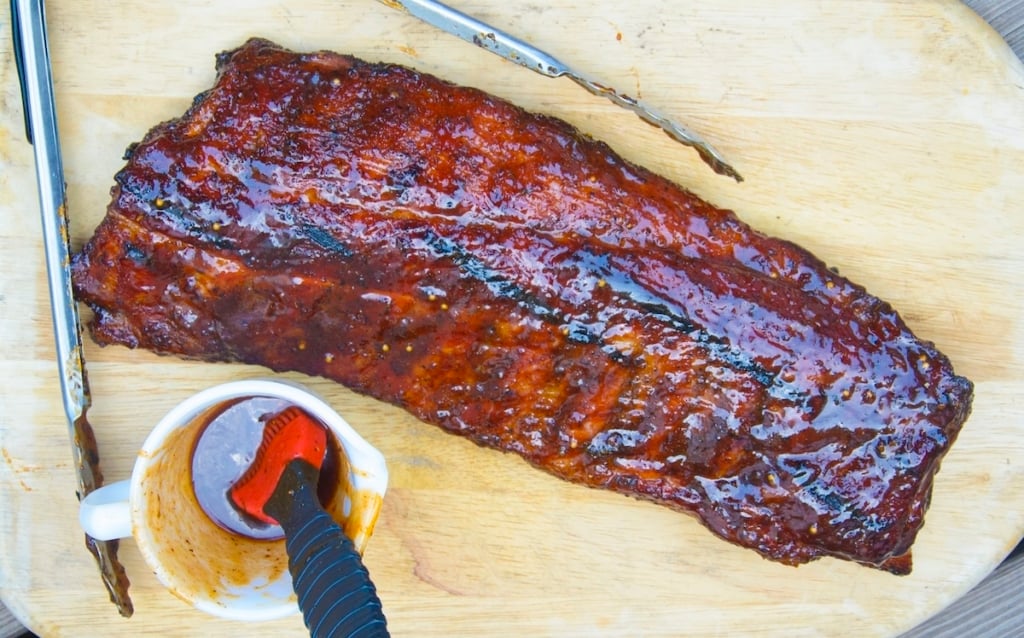


High quality websites are expensive to run. If you help us, we’ll pay you back bigtime with an ad-free experience and a lot of freebies!
Millions come to AmazingRibs.com every month for high quality tested recipes, tips on technique, science, mythbusting, product reviews, and inspiration. But it is expensive to run a website with more than 2,000 pages and we don’t have a big corporate partner to subsidize us.
Our most important source of sustenance is people who join our Pitmaster Club. But please don’t think of it as a donation. Members get MANY great benefits. We block all third-party ads, we give members free ebooks, magazines, interviews, webinars, more recipes, a monthly sweepstakes with prizes worth up to $2,000, discounts on products, and best of all a community of like-minded cooks free of flame wars. Click below to see all the benefits, take a free 30 day trial, and help keep this site alive.
Post comments and questions below
1) Please try the search box at the top of every page before you ask for help.
2) Try to post your question to the appropriate page.
3) Tell us everything we need to know to help such as the type of cooker and thermometer. Dial thermometers are often off by as much as 50°F so if you are not using a good digital thermometer we probably can’t help you with time and temp questions. Please read this article about thermometers.
4) If you are a member of the Pitmaster Club, your comments login is probably different.
5) Posts with links in them may not appear immediately.
Moderators